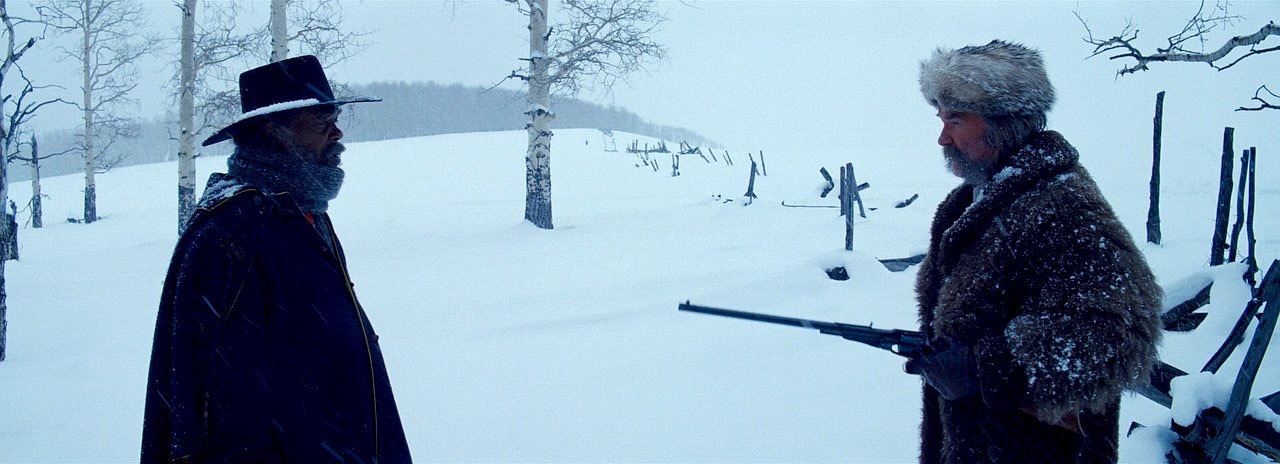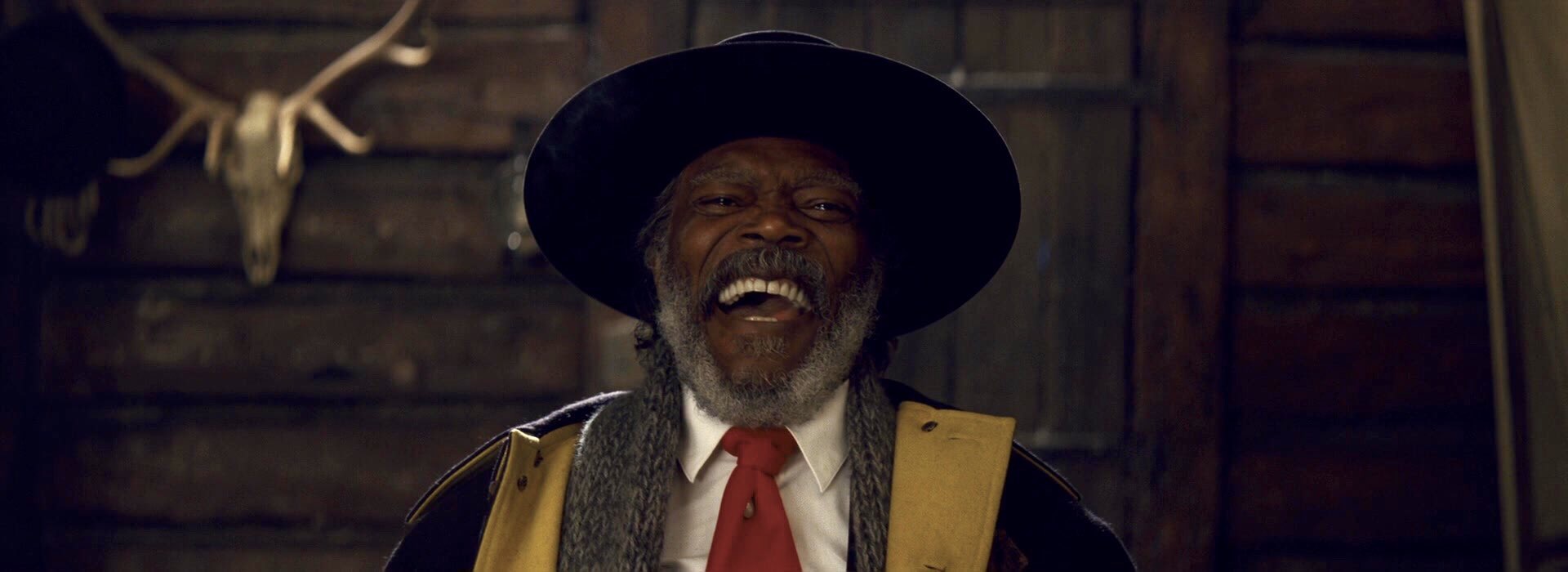Quentin Tarantino’s first 25 years, Part 9 – The Hateful Eight (2015).
“The name of the game here is patience.”
So says Channing Tatum’s character, Jody in Quentin Tarantino’s ninth feature film (he says it’s his eighth but I’d question his ability to count) and patience may play a big part in ones viewing experience of The Hateful Eight. Patience was first required in the long wait where Tarantino mooted his second western themed feature where nothing much but the title was known for quite some time. The screenplay was famously leaked online, something which caused the director to almost walk away from the project until the enthusiastic response of his actors lead to him realising that leak or no leak, his film had merit and he persevered.

Released in late December 2015, The Hateful Eight is only the eleventh film to be shot in the Ultra Panavision 70mm process (65mm film with 1.25x squeeze anamorphic lenses, for a projected aspect ratio of 2.76:1). Unbelievably, the last film to utilise this process was Khartoum way back in 1966, nearly fifty years before. In order to shoot the film, Tarantino sought out several original Panavision cameras and had the lenses appropriately modified to be mounted on more modern camera rigs.

As of 2015, most theaters around the world had had their film projectors replaced with digital projectors, as traditional film stock was no longer in favour. As a supporter of the traditional celluloid filming process, Tarantino fought with distributors for the film to be shown in its original Ultra Panavision 70 presentation. As a result, 50 U.S. theatres were retrofitted with anamorphic-lensed 70mm analogue film projectors in order to display the film as the director intended it to be seen. It was released initially as a roadshow presentation in 70mm analogue format theaters exclusively before being released in digital theaters on December 30th, 2015.

The Weinstein Company spent nearly $10 million to find, procure, rebuild, and install the 70mm analogue film projectors and to train the 200 projectionists needed to operate them in the 96 U.S. theatres that showed the Roadshow version of the film which clocks in at 187 minutes. The Regular or Multiplex Version which omitted the Roadshow Version’s 4 minute Overture and 12 minute Intermission is 167 minutes and also removes approximately six minutes of footage that Quentin Tarantino felt played better in the 70mm format.

The film’s exteriors would be shot entirely within southwest Colorado. The state funded the production with $5 million so as to ensure as much of the stunning Colorado scenery as possible was seen. Cinematographer Robert Richardson perfectly utilised the widescreen composition, the same ultra-wide aspect ratio as used in William Wyler’s multi-Oscar winning Ben-Hur (1959) to make the most of this beautiful part of the world.

On a budget of $44 million, The Hateful Eight took in a worldwide gross of only $155 million. Taking into account the marketing costs, which in most cases don’t form part of a film’s production budget, and are in addition to the cost of making the film, The Hateful Eight was something of a failure in many respects. Opening against the full-on tidal wave that was Star Wars: The Force Awakens no doubt did little to help it’s box office success. It fared reasonably well with critics and holds a Metacritic score of 68% but was nowhere near the success of Tarantino’s first foray into Western territory, 2012’s Django Unchained.

The Hateful Eight is the last film in my recent look back at the films of Quentin Tarantino’s first quarter century. It’s the Tarantino film I’ve seen the least and one that I’ve really struggled to settle on with regards to how I feel about it. There are certain things of which I’m in no doubt about such as Robert Richardson’s gorgeous ultra widescreen cinematography. The snow covered Colorado vistas are simply jaw dropping. The colour timing is spot on and the film has a satisfying realism to the colour palette that makes the most of the natural beauty of the film’s environs.

The film opens with Kurt Russell’s, very much John Wayne inspired bounty hunter, John Ruth, taking his latest quarry, the wanted and very much crazy, Daisy Domergue (an Oscar nominated Jennifer Jason Leigh) to be hanged for her crimes in the town of Red Rock. On the way they meet Samuel L. Jackson’s Major Marquis Warren, another bounty hunter who’s taking his quarry, a pile of dead bodies, to Red Rock to claim the bounty upon them.

It’s at this point where the first of my frustrations with The Hateful Eight arises. Now whilst a film’s visuals should never take precedence over the story it’s trying to tell, for what fees like the next twenty minutes or so, we are confined to the horse drawn carriage our characters occupy and little is seen of the glorious scenery beyond. This wouldn’t be so much of a bad thing if the dialogue had that same punch and addictive quality of say, that first scene between Sam Jackson and John Travolta in Pulp Fiction. It’s far from disinteresting but having been wooed by such incredible scenery early on, my eyes yearned for more of the same eye candy and I found what was going on in the carriage to be of insufficient compensation. We see little more of Colorado before our three characters, now conveniently joined by a fourth, Walton Goggins’ Chris Mannix, who’s on his way to become the new Sheriff of Red Rock. The convenience of these four people meeting – some of whom know each other having met before, others familiar purely by reputation – is at odds with the vastness of their environment and just a tad contrived for my liking but I’ll give it a pass as Tarantino’s films have always existed in their own hyper-reality, somewhat adjacent to our own.

There’s a storm closing in so our characters take refuge in Minnie’s Haberdashery, a remote but comfortable retreat from the harsh weather. Inside, instead of Minnie and her staff, who are conveniently known to Ruth, there are now four strangers who’ve also taken refuge there. What follows over the course of near enough the next two hours is a game of whodunnit, or more accurately ‘Who is it?’ as in, who is the person out to spring Daisy. The influence of the novels of Agatha Christie can be clearly seen here. Through the use of a rather clumsily convenient reveal from Daisy – the word ‘convenient’ seems to be cropping up with some regularity here – we learn rather inexplicably that one (or more) of these four men is allied to Daisy and it’s our character’s slowly increasing suspicions that play out for much of the remainder of this far from slight film.

Tarantino has stated that one of the biggest influences on his debut film, Reservoir Dogs, was John Carpenter’s stunning 1982 sci-fi/horror The Thing, and more than any other film, The Hateful Eight has direct parallels to the Carpenter classic. Both films feature a seemingly disparate group of individuals isolated by the raging snow storm outside. Both groups are racked by the growing suspicion that one or more of them may not be what they appear to be and may pose a significant threat to the others, this distrust eventually causing them to turn on each other. And the real deal clincher is that both films feature scores by Ennio Morricone. In fact, the legendary composer uses a large chunk of his own unused score from Carpenter’s 1982 film in The Hateful Eight, and perfectly fitting it is too.

Tarantino’s trademark snappy dialogue is no doubt here as is his penchant for larger than life characters. With an exemplary cast that includes Tarantino stalwarts Tim Roth, Michael Madsen and the wonderful Bruce Dern (he had a small role in Django Unchained) adding to the already stellar talents of Russell, Jackson and Jennifer Jason Leigh, the stunning cinematography of Robert Richardson and none other than Ennio Morricone providing the film’s score – the ingredients are there for an exquisite movie.

Unfortunately, having tragically lost his greatest collaborator, editor Sally Menke in 2010, Tarantino slips into self indulgence to a certain degree here. There’s simply too much extraneous material that fails to propel the narrative nor add with regularity to the mounting tension. One particularly drawn out confrontation between Sam Jackson’s Marquis Warren and Bruce Dern’s General Sandy Smithers, seems to do nothing more than provide Sam Jackson with a rather vulgar diatribe and us, the viewer with a reason (via flashback) to see more of that stunning Colorado scenery and then give Warren reason to dispose of Smithers. With some judicious trimming, be it in the writing stage or eventual editing phase, a far more efficient and therefore engaging film could have been crafted here. It’s a problem that reared it’s head in Django Unchained but to much less of an extent. The film simply goes on too long and coupled with the often unforgivable plot contrivances, The Hateful Eight occupies a place in the lower levels of my own personal ranking of Tarantino’s films.

All that said, I wouldn’t be being honest with both myself and you, our valued readers, if I didn’t admit that for reasons that may yet become clear, I’m really eager to watch The Hateful Eight for a third time. The parallels between it and The Thing, with its bleak yet somehow still satisfying denouement, are worthy of further examination. Some of the performances are genuinely great, and when the violence does erupt, it does so with the usual Tarantino level of gasp-inducing excess. The score is superb and when it ventures beyond its frustrating confines, the film looks remarkable.

It’s a strange journey that I’ve embarked upon through these nine films to finish on one that has caused me a degree of unexpected uncertainty. Initially I found that I had more disdain for the film than any overly positive feelings towards it but that second viewing helped resolve some, but not all of those issues. It’s clear that The Hateful Eight is a flawed, flabby film but even then it has considerable scope, strong performances from an exemplary cast and layers of merit that simply cannot be brushed aside. It falters in comparison to Tarantino’s stronger efforts, but by any other measure of quality it’s a film that is certainly worthy of recommendation. I feel it’s a film that may either be forgotten as time goes on or may possibly be rediscovered and venerated. The name of the game may well be patience after all.
Film ‘89 Verdict – 7/10

